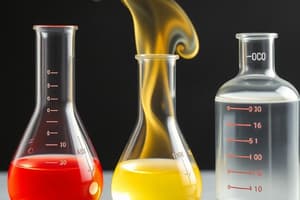Podcast
Questions and Answers
A gas occupies 5.0 L at a pressure of 2.0 atm. If the volume is increased to 10.0 L while keeping the temperature constant, what will be the new pressure?
A gas occupies 5.0 L at a pressure of 2.0 atm. If the volume is increased to 10.0 L while keeping the temperature constant, what will be the new pressure?
- 0.5 atm
- 2.0 atm
- 4.0 atm
- 1.0 atm (correct)
A container of gas has a volume of 6.0 L at standard pressure (1 atm). If the pressure is changed to 3 atm, what is the new volume, assuming constant temperature?
A container of gas has a volume of 6.0 L at standard pressure (1 atm). If the pressure is changed to 3 atm, what is the new volume, assuming constant temperature?
- 9.0 L
- 2.0 L (correct)
- 18.0 L
- 3.0 L
A gas occupies 22.4 L at a pressure of 760 mmHg. What volume will it occupy if the pressure is increased to 1520 mmHg while maintaining a constant temperature?
A gas occupies 22.4 L at a pressure of 760 mmHg. What volume will it occupy if the pressure is increased to 1520 mmHg while maintaining a constant temperature?
- 33.6 L
- 44.8 L
- 11.2 L (correct)
- 22.4 L
A balloon contains 10 L of air at 27 degrees C and 1 atm pressure. If the pressure is doubled, and the temperature is kept constant, what is the new volume of the balloon?
A balloon contains 10 L of air at 27 degrees C and 1 atm pressure. If the pressure is doubled, and the temperature is kept constant, what is the new volume of the balloon?
A gas occupies a volume of 10.0 L at standard pressure. If the pressure is tripled, what will the new volume be, assuming the temperature remains constant?
A gas occupies a volume of 10.0 L at standard pressure. If the pressure is tripled, what will the new volume be, assuming the temperature remains constant?
A gas has a volume of 250 mL at 2 atm. If the pressure is reduced to 0.5 atm, what is the new volume if the temperature is held constant?
A gas has a volume of 250 mL at 2 atm. If the pressure is reduced to 0.5 atm, what is the new volume if the temperature is held constant?
A sample of gas occupies 2.0 L at 1.0 atm. If the pressure is increased to 4.0 atm while keeping the temperature constant, what is the new volume?
A sample of gas occupies 2.0 L at 1.0 atm. If the pressure is increased to 4.0 atm while keeping the temperature constant, what is the new volume?
A gas occupies 500 mL at a pressure of 700 torr. What volume will it occupy at standard atmospheric pressure, ≈760 torr, assuming constant temperature?
A gas occupies 500 mL at a pressure of 700 torr. What volume will it occupy at standard atmospheric pressure, ≈760 torr, assuming constant temperature?
Flashcards
Boyle's Law
Boyle's Law
Boyle's Law states that the volume of a gas is inversely proportional to its pressure, assuming constant temperature and amount of gas.
Boyle's Law Formula
Boyle's Law Formula
P1V1 = P2V2, where P is pressure and V is volume. The '1' and '2' subscripts denote initial and final conditions.
Standard Pressure
Standard Pressure
Standard pressure is defined as 1 atmosphere (atm), which is equal to 760 mmHg or 101.3 kPa.
Consistent Units
Consistent Units
Signup and view all the flashcards
Inverse Relationship
Inverse Relationship
Signup and view all the flashcards
Solving for Volume/Pressure
Solving for Volume/Pressure
Signup and view all the flashcards
Halving the Pressure
Halving the Pressure
Signup and view all the flashcards
Pressure conversions
Pressure conversions
Signup and view all the flashcards
Study Notes
Boyle's Law
- Boyle's Law describes the relationship between the pressure and volume of a gas
- The formula for Boyle's Law is P₁V₁ = P₂V₂
- P represents pressure
- V represents volume
- As volume increases, pressure decreases (V ↑ P↓)
Worked Example
- A gas occupies 12.3 liters at a pressure of 40.0 mmHg
- Volume is calculated when the pressure is increased to 60.0 mmHg as follows:
- P₁ = 40.0 mmHg
- V₁ = 12.3 liters
- P₂ = 60.0 mmHg
- V₂ = ?
- Using Boyle's Law: P₁V₁ = P₂V₂
- Substituting the values: (40.0 mmHg) (12.3 liters) = (60.0 mmHg) (x)
- Solving for x: x = 8.20 L
Conversions
- 1 atm (atmospheric pressure, "atmosphere," or standard pressure) = 760 mmHg
- 1 torr = 1 mmHg
Practice Problems
- Problem #2: Calculate the volume of a gas initially at 25.0 °C occupying 3.60 liters at 1.00 atm, when the pressure becomes 2.50 atm
- Problem #3: Calculate the pressure needed to compress a gas from 400.0 cubic feet to fit into a 3.00 cubic foot tank at standard pressure
- Problem #4: Calculate the volume of a gas initially occupying 1.56 L at 1.00 atm, when the pressure increases to 3.00 atm
- Problem #5: Determine the pressure of a gas initially occupying 11.2 liters at 0.860 atm, when the volume changes to 15.0 L
- Problem #6: Calculate the volume of 500.0 mL of gas collected at 745.0 mmHg at standard pressure
- Problem #7: Convert 350.0 mL of gas at 740.0 mmHg to its new volume at standard pressure
- Problem #8: Convert 338 L of gas at 63.0 atm to its new volume at standard pressure
- Problem #9: Convert 273.15 mL of gas at 166.0 kPa to its new volume at standard pressure
- Problem #10: Convert 77.0 L of gas at 18.0 mmHg to its new volume at standard pressure
- Problem #11: Determine whether the volume increase or decrease when pressure on a gas increases
- Problem #12: Find out how the volume changes when the pressure on a gas is halved
- Problem #13: Calculate the volume of a gas initially occupying 4.31 liters at 0.755 atm, when the pressure increases to 1.25 atm
- Problem #14: Calculate the volume of a gas initially at 600.0 mL at 8.00 atm, when the pressure decreases to 2.00 atm
- Problem #15: Calculate the volume of a gas initially at 400.0 mL under 800.0 torr, when the pressure increases to 1000.0 torr
Bonus Problem
- A balloon is designed to inflate to a max volume of 2.5 liters
- The balloon is filled with 2.0 liters of helium at sea level (101.3 kPa)
- Determine if the balloon will burst as it rises to an altitude where the boiling temperature of water is 88 degrees Celsius
Studying That Suits You
Use AI to generate personalized quizzes and flashcards to suit your learning preferences.
Related Documents
Description
Explanation of Boyle's Law, which defines the relationship between the pressure and volume of a gas at constant temperature and mass. Includes a worked example and practice questions. Also contains some useful conversions.



